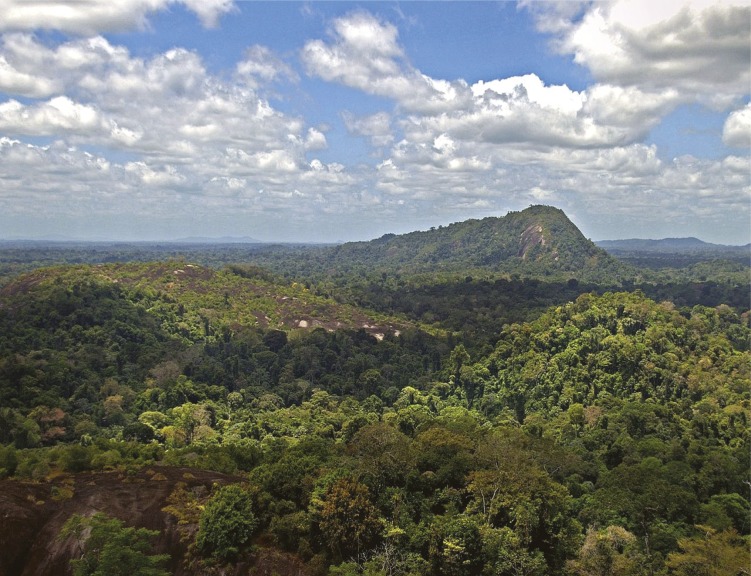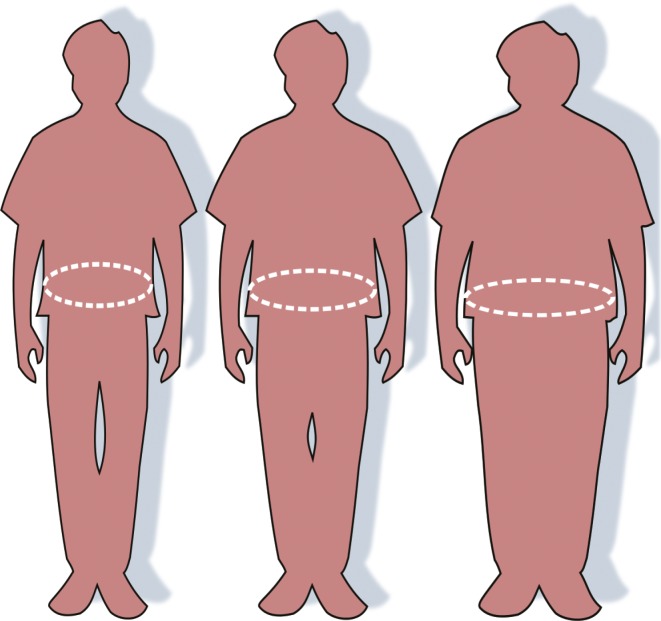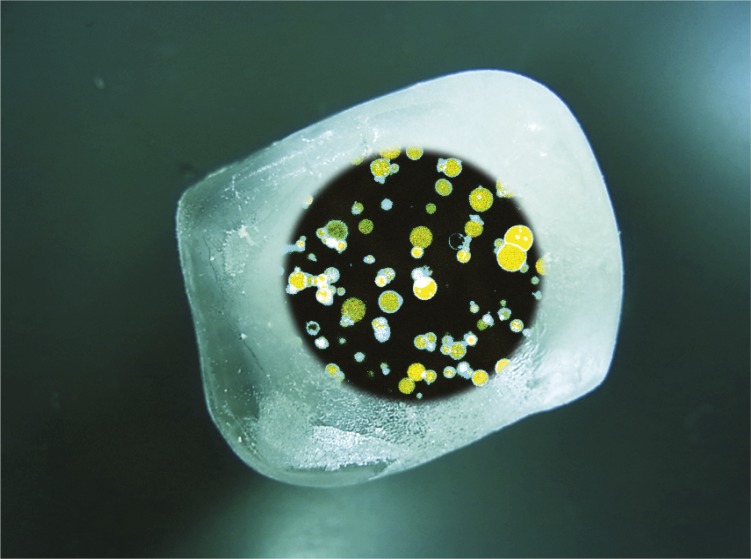Response of Amazon to climate change
Amazon rainforest in Suriname. Image courtesy of Flickr/David Evers.
Previous studies have predicted that the Amazon region will experience longer and more intense dry seasons by the end of the century, but how Amazon forests will respond to this change is uncertain. Naomi Levine et al. (pp. 793–797) combined remote-sensing and ground-based observations with an advanced ecosystem model to estimate the sensitivity of Amazon forests to climate change. The Ecosystem Demography Biosphere (ED2) model incorporates the effect of water stress on the productivity of individual plants in contrast to traditional models that average this effect across plant species and environments. Unlike traditional ecosystem models, which predict either no change or a sudden switch from a forest-dominated to a grass-dominated savannah ecosystem, ED2 predicted a graded transition from high-biomass forest to low-biomass forest and woodland ecosystems with increasing water stress, consistent with the observed relationship between biomass and dry season length. The reduction in biomass that occurs in response to increased dry season length is correlated with the initial length of the dry season and with the clay content of the soil. These results suggest that Amazon forests are more sensitive to small changes in climate than previous studies have suggested, but that the forests are unlikely to undergo a sudden switch from one ecosystem type to another, according to the authors. — B.D.
Radioisotopic chronology reveals dinosaur origins
Animals escaping from an erupting volcano 235 million years ago in northwestern Argentina. Image courtesy of Victor Leshyk.
The early history of dinosaurs remains clouded by uncertainty. Details of the emergence and ascendancy of dinosaurs remain unclear, largely because the fossil record is poorly constrained in time and space. Focusing on the Chañares Formation in northwestern Argentina, Claudia Marsicano et al. (pp. 509–513) produced high-precision radioisotopic ages for the mineral zircon in key stratigraphic sequences across the boundary between dinosaurs and their precursors, known as dinosauromorphs. These ages, combined with other well-documented chronologies from the same basin, suggest that dinosaurs emerged in a relatively short span of around 5 million years. In addition, the new timeline halves the temporal gap between assemblages that contain only dinosauromorphs and those that contain the first known dinosaurs. The latter result suggests that despite their rapid emergence, dinosaurs rose to prominence along a relatively smooth and gradual trajectory without causing a fundamental shift in the ecosystem. The findings may have implications for a number of commonly cited fossil chronologies that currently lack radioisotopic ages and independent dating, according to the authors. — T.J.
Tunable tag for protein imaging
Cytoplasmic Y-FAST fusion in mammalian cells is switched on and off by adding and withdrawing the dye 4-hydroxy-3-methylbenzylidene-rhodanine (HMBR).
Since the 1990s, molecular biologists have tagged biomolecules with proteins that fluoresce when exposed to light to observe and decipher fundamental cellular processes. Although green fluorescent protein (GFP), a well-known tracer, has long been used for protein imaging, most GFP-like proteins are too large, slow to fluoresce, and unstable for many applications. Marie-Aude Plamont et al. (pp. 497–502) describe a protein tag dubbed Yellow Fluorescence-Activating and absorption-Shifting Tag (Y-FAST), which is much smaller in size than GFP and fluoresces instantaneously upon activation by a cell-permeant and nontoxic ligand. The authors engineered Y-FAST from photoactive yellow protein using directed evolution, a laboratory technique that mimics the process of natural selection to produce proteins with specific characteristics. The engineered traits allow Y-FAST to label targets with a high degree of selectivity and in a reversible manner, thus providing a fluorescence on/off switch. According to the authors, Y-FAST compares favorably to other fluorescent proteins in terms of brightness and stability and is less likely to perturb the normal function of its binding targets. — T.J.
Relationship between maximum weight and mortality
Obesity may be a risk factor for mortality even after losing weight. Image courtesy of FDA/Renée Gordon.
Typical studies of the effects of obesity on mortality are based on body mass index (BMI), recorded at a single point in time. Such an approach does not account for changes in BMI over time that could potentially be related to mortality, such as illness-associated weight loss. Andrew Stokes and Samuel Preston (pp. 572–577) compared mortality estimates obtained through this conventional approach with those obtained from alternative models that incorporate individuals’ maximum weight. The authors obtained BMI data for over 6,000 Americans ages 50–74 from the 1988–2010 National Health and Nutrition Examination Survey, and mortality data from death records through 2011. Using statistical information criteria, models that incorporated information on maximum BMI consistently performed better than the conventional model using only BMI at the time of survey. Among individuals who were of normal weight (18.5–25 kg/m2) at the time of survey, those who had formerly been in a higher weight class had a higher mortality rate than those who never exceeded normal weight. According to the authors, the failure to distinguish formerly obese individuals from those who were never obese in prior studies may have obscured the health consequences of overweight and obesity. — B.D.
Quantum violation of the pigeonhole principle
The pigeonhole principle and quantum mechanics. Image courtesy of Flickr/esartee.
The pigeonhole principle is a fundamental principle of nature that states that if three objects are placed in two boxes, at least two of the objects must end up in the same box. Yakir Aharonov et al. (pp. 532–535) found that there are certain cases in quantum mechanics in which the pigeonhole principle is violated. The authors demonstrated such cases by supposing that each of three particles have an equal probability of being in one of two boxes. Under certain circumstances, the authors report, the rules of quantum mechanics require that the probability of any two particles being in the same box has to be zero. Thus, there are three particles in two boxes, yet no two particles are in the same box. The authors term this result the quantum pigeonhole principle, generalized to any number of particles and boxes, provided that there are fewer boxes than particles. According to the authors, the results may have implications for understanding fundamental concepts such as correlations and interactions. The authors also propose experiments that could demonstrate the effects of the quantum pigeonhole principle. — B.D.
Sustainable protocell proliferation in culture
Protocell model proliferates by iterative freeze–thaw.
Growth of model cells for studies of the origin of life requires both replication of genetic information and the proliferation of the phospholipid vesicles containing this information. Yet it has been difficult to attain sustainable proliferation of phospholipid vesicles. Gakushi Tsuji et al. (pp. 590–595) demonstrate a protocell model that can be sustained in culture. The authors used a freeze–thaw technique to combine nutrient liposomes containing the enzyme RNA-replicase and nucleotide triphosphates with liposomes containing RNA. The nutrient and RNA liposome solutions were mixed and centrifuged, following which liquid nitrogen was used for the freeze–thaw procedure. Following the freeze–thaw, lipid mixing and spontaneous fission of liposomes could be observed. Fused liposomes included multiple fluorescent lipid markers. Sustainable proliferation of liposomes was demonstrated through 10 cycles of growth in culture with repeated addition of nutrients. Measurement of dye fluorescence by flow cytometry indicated RNA replication within the liposomes and RNA distribution to daughter liposomes. The simultaneous supplementation of nutrients for RNA replication and membrane material for liposome proliferation may be a method by which protocells were able to grow early in Earth’s history, according to the authors. — L.G.








